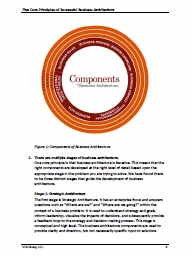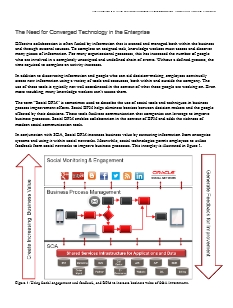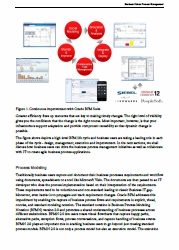Home / Resources
Resources
Discover a Wealth of BPM Knowledge and Expertise at BPMInstitute.org!

Business Architecture: The Real Tie that Binds
By William Ulrich & Jim Rhyne
A recently published article entitled “Business Capability Architecture Is the Tie that Binds All” discussed how to use business capabilities to tie business strategy, enterprise change, and project portfolio prioritization.[i] We concur that strategy, enterprise change, and portfolio management are managed more effectively using business architecture, and agree that capabilities are a component of business architecture However we view the article’s notion of “business capability architecture” as being incomplete. We will discuss why this concept is incomplete and how it can be extended through value mapping.

A Process Based View of Customer Experience
A recent article in HBR informed readers on the “truth” about customer experience[i]. The authors argued that it’s not enough for organizations to excel at key touch points with customers – instead organizations need to understand and skillfully manage the entire customer journey. While this is true – and might be a new revelation for some readers – it should come as no surprise to those of us who have practiced a customer focused, process based view of business.
A process based view of customer experience is much more than just creating a roadmap of a customer journey; it also involves shaping what the organization measures and manages. Let’s consider how a process based view of customer experience can benefit service providers such as phone, internet, cable, and utility companies. The customers of such service providers have a set of very simple needs; including,

Government Transformation Depends On Dynamic Portfolio Management
“We can’t solve problems by using the same kind of thinking we used when we created them.” – Albert Einstein
In the 21st century, government transformation initiatives have become increasingly more common, rather than exceptional. Some ambitious public sector initiatives turn out to be at least partially successful, though many others do not. Even when transformation success is declared, the outcome is often plagued by significant limitations that must be dealt with for many years.

Organisation Ring of Influence
A famous quote, “Installing a Rolls Royce engine in a Hyundai can make it inoperable,” (Russell Ackoff, 1999) as used to explain why improving parts of a system can be detrimental as opposed to improving the entire system, could also be used to explain why you should consider improving Business Process Reengineering BPR project execution as part of an organisation in terms of how they operate and not just by focusing on the technical execution of a project in terms of the project lifecycle. In other words the “BPR Project System” is made up of the environment in which it is executed as well as the BPR project itself inclusive of its execution method, its team structure, its project objectives and execution deliverables.

The Illusive Bridge between Business Architecture and IT
In this world of “It’s not my job!” thinking, I look at the practice of business architecture and noticed that nowhere does anyone discuss business requirements as part of business architecture. “We are not IT, we are aligned to the business.” Yet, one of the values of business architecture is to create the bridge between business and IT which means at some point we need to be involved in translating business requirements or business needs.

Five Core Principles of Successful Business Architecture
Despite the massive efforts undertaken in many organizations, the promises of the latest business trends have often failed to come to fruition. This is not the result of lack of effort, smart people, software tools, new ideas, or new approaches. It is due to the absence of a holistic, business-centric approach to solving the complex challenges within a company. This approach is business architecture. This whitepaper explores five core principles of business architecture and provides important facts that are valuable to know before beginning, or when evaluating an existing internal business architecture program.

Building a Process Catalog: Moving Ahead
This is the third in a series. The first installment, Building a Process Catalog – The Journey Begins, was published in the April BPM Institute’s online journal. The second installment, Building a Process Catalog, The Ongoing Journey, was featured in the August bulletin.
Recap
My first two features described how I use SIPOC (Supplier, Input, Process, Output, Customer) diagrams to capture some essential characteristics of major business functions.

Business Architects Architect your Success
I am not an enterprise architect. I’m a business architect. The difference lies in the customers we primarily serve. Historically, the business architecture perspective has been part of every enterprise architecture framework. Only recently has there been a clamor to treat business architecture as a separate profession and discipline with its own set of culture, adherents, and customers.

Process Centric Enterprise Architecture: Aligning with Successful Customer Outcomes
Every primary process in the Enterprise Architecture should have some bearing on how it affects the customer. The process, its activities and the resources to perform the activities should be geared towards achieving Successful Customer Outcomes. When we state the requirements for the services, the processes, the resources and the IT systems or when we design or develop the solution, the interaction with the customer and the goals of the customer should be stated and represented clearly.
I discussed the process centric approach to Enterprise Architecture in a previous article. In this article I will focus on the solutions from such architecture.
How do we change our solutions to achieve Successful Customer Outcomes?

Automating Capture to Transform Unstructured Data Processes
We live in a fast paced world where consumers demand high quality and rapid services. When we buy an item on-line we expect a confirmation email in seconds or we start to be concerned that something has gone wrong.
The desire for rapid and meaningful response is also growing in more complex transactions such as a mortgage or insurance application, even though these often require documents to be supplied that contain the data needed to decide on the claim or application. Consumers can now take and send pictures on mobile devices or scan documents from home, and are attracted by the simplicity and availability of 24/7 e-business.
When transforming these types of business process a capture strategy is needed to enable documents to be delivered and processed in a fast and low cost means, with a consistent high level of quality.

A Non-Profit Profits From Business Architecture
Large companies do not have exclusivity on using the discipline of business architecture. Smaller companies and non-profits can derive tremendous value by leveraging the discipline.
Like many other states, the funding for schools in Illinois has been on the decline. A concerned group of local citizens in one town wanted to do something about it. They started a non-profit Foundation with the goal of raising funds from the local community; funds that will be used to supplement the loss of revenue from the state.
A major strength of this Foundation is the high degree of enthusiasm amongst its members. There is no dearth of ideas on how to raise funds and how to spend it. Proposals for fund raising range from holding bake sales to getting corporate sponsorships. Likewise, proposals for spending those funds range from educational excursions for students, to buying equipment for the school.

Process Centric Enterprise Architecture: Towards an agile Enterprise and Architecture
We live in a process powered world and the only thing the customer is interested in is WIFM (What’s in-it for me?). Customers are tired of hearing phrases such as “customer centric” and “world class” and “service oriented”. If your process outcomes are not aligned to the customer’s goals and you do not provide an excellent service (note: not a superior product) – guess what?
How does this affect Enterprise Architecture?
If an organisation doesn’t change its way of developing products for more than 40 years, do we expect that organisation to stay in business for very much longer?

Process Governance: Leadership or Management?
Gartner’s definition of BPM is “a management practice that provides for governance of a business’s process environment toward the goal of improving agility and operational performance.“
The definition implies that BPM has both management and leadership and I agree. I would clarify further: leadership of the environment and management of the practices. Let’s see how they both play out by looking at the What, Who, When, and Where of Process Governance.
WHAT are the elements of Process Governance?
There are two important streams to governance:
Leadership includes:
- Accountability and Decision Making
- Vision and strategy
- Process Prioritization
- Regular Monitoring
Management includes:

Business Rules: Going Old School with Expert Systems
During a recent client meeting, we were reviewing the proposed business architecture for a new system. Decision Management will play a crucial role in the application and the rule processing had been nicely delineated in the architecture. While the rules themselves had been fairly well articulated, their “insertion” in the requirements suggested quite a bit of work remained. However, I was generally pleased with the state of the work to date.

Enterprise Capital Planning and Business Architecture
David Starr Jordan, founding president of Stanford University, said “Wisdom is knowing what to do next, skill is knowing how to do it, and virtue is doing it.” It applies to enterprises as much as it does to individuals. Modern enterprises rely on the capital planning process to determine “what to do next” and “how to do it”, which results in change programs for the enterprise. These change programs are then implemented via standard portfolio management processes of the enterprise. Capital planning depends on a clearly defined business strategy and a good understanding of the current state of the enterprise.

Transforming Customer Experience
The Convergence of Social, Mobile and Business Process Management
To stay ahead in todays rapidly changing business environment, organizations need agile business processes that allow them to adapt quickly to evolving markets, customer needs, policies, regulations, and business models. The convergence of a trio of technologies and business practices – social computing, mobile computing and business process management (BPM) – is opening up interesting avenues for business.

For Most Government Agencies, an IT Strategy Can Be One Too Many
For years, I’ve been telling my federal customers that an IT Strategy is often not very helpful, and that all of an agency’s resources (whether people, processes, technologies, services, or facilities) should be collectively aligned and applied to enable a single enterprise strategy that is driven by mission and business needs – in short, an Enterprise Business Strategy. “Instead of an IT Strategy,”1
I would go on to say, “What an agency needs is an IT Roadmap.” Despite that advice, which did go against the grain of prevailing government practices, nearly every CIO would persist in his or her efforts to promulgate an IT Strategy – as an emblem or accoutrement of the office they held, it often seemed.

Error Tracking in Processes
Lean six sigma methodologies focus on removing wasteful activities from processes. However, at times we need process activities that come in handy when the expected process is not followed or are essential for fraud prevention and/or regulation. During my recent trip to India I came across two such examples, which made me think about the importance of compliance, fraud detection and customer centric activities that correct process deviation. While these activities may not further process KPI’s, they are certainly necessary. As in everything, it is all about striking a balance. Add too many such activities and your process may not be “lean”, not having any may lead to issues in other related processes. Let me describe both these examples.
Airport Security:

Business Driven Process Management
Changing market drivers, increasing competitive pressures, global presence and rapidly evolving customer needs are placing greater pressure on businesses to streamline their processes and take control. The “B” in BPM stands for Business, and these are the people who interact with the process on a regular basis, who understand the operational limitations, and who have ideas for improving the process. There is an increasing desire among the business users to get into the driver’s seat while creating business applications. Business users want to manage the design and execution of business processes. This is especially true for business processes where IT has been unable to keep pace with changing business needs. Oracle BPM enables business users to take control and drive improvements for their processes.

Building a Process Catalog: The Ongoing Journey
Recap
In the last article, I described a project to capture and catalog the major cross-functional processes within a 7-department business unit. The article provided an example of a modified Supplier, Input, Process, Output, Customer (SIPOC) diagram, discussed the problem statement, and described the steps we took to get buy-in from the Sr. Management of the business unit.
This time, we’ll explore the modified SIPOC in greater detail to illustrate how it is created, and how it can be used. We’ll discuss the catalog that is the inventory list of the SIPOC processes that have been diagrammed.













